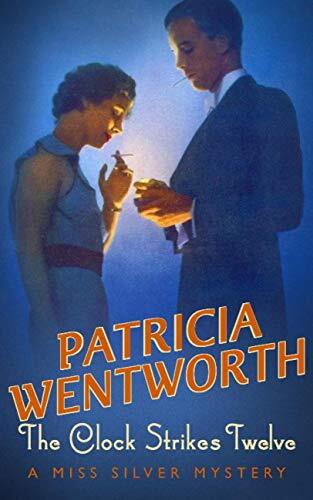The Clock Strikes Twelve

A review of The Clock Strikes Twelve by Patricia Wentworth
It has taken a while, but I am beginning to warm to Patricia Wentworth and her Miss Silver series, of which The Clock Strikes Twelve, originally published in 1944, is the seventh. It can be called a typical country house murder mystery in that James Paradine dies in his pile and the only probable suspects are those who attended the dinner on New Year’s Eve, 1941.
Wentworth makes the decision, rightly, to spend much of the first half of the book developing the characters of the various relatives who were seated around the dinner table and exploring their complex relationships. It would not be a Wentworth book without a love match that is going off the rails, a marriage between Phyllida, James Paradine’s adopted niece, and Errol Wray, who works for the family firm, that hit the rocks almost as soon as it had begun. However, rather than being an unnecessary distraction, the dynamics of the relationship are central to the plot and gives some sense to what happened on that fateful New Year’s Eve.
Wray’s arrival at the dinner after a year’s separation from his wife causes feathers to fly and the atmosphere is further poisoned when Paradine announces that someone at the dinner table has betrayed the family interests, that he knows who that person is, and that he will be in his study until twelve o’clock to give that person time to confess, and to make amends. The cat firmly put among the pigeons, some of the guests leave as soon as it is socially acceptable to do so, leaving the others to wonder what James meant and what the problem was.
During the course of the evening, there were several comings and goings to Paradine’s study, even visits by some who had seemingly made an early exit, and, inevitably, Paradine is found dead just after midnight, having taken a tumble over a low parapet. Was he pushed or was it an accident?
The police investigations clearly suggest that James was murdered and with good reason they believe that the main beneficiary of James’ will is their prime suspect. He agrees to call in the services of Miss Silver who just happens to be in the area. Oddly, the police seem grateful for her assistance. It emerges that there were two incidents that may have provoked James’ ire – some secret plans that he was working on had disappeared, albeit temporarily, and the replacement of his pride and joy, some diamonds, with jewels made of paste.
Much of the investigation takes the form of examining the stories and alibis of the guests, some of whom see fit to change their stories as time goes on. These sections of a book can be tedious but Wentworth, as always, has a light touch and a fine sense of pace, dwelling on each aspect sufficiently for the reader to get the gist of what is going on, but not long enough for them to lose the will to live. There are enough twists and turns and red herrings to satisfy the most demanding of Wentworth’s readers, even if the plot is not that complex and the culprit is relatively easy to spot.
Miss Silver is more of an intuitive sleuth, a reader of people’s characters and motivations, rather than a deductive investigator. Like her knitting, the pieces all begin to hang together, and she is able to reveal what has gone on, the identity of the culprit and their motives in a set piece in front of all the suspects. The named culprit takes matters into their own hands, but the book, cleverly, ends on a note of ambiguity. There is another culprit who could easily have killed Paradine. Were they pipped to the post by the other person, or did they really do it?
I found it a thoroughly enjoyable read, and one which renewed my faith in Camberley’s finest author.



